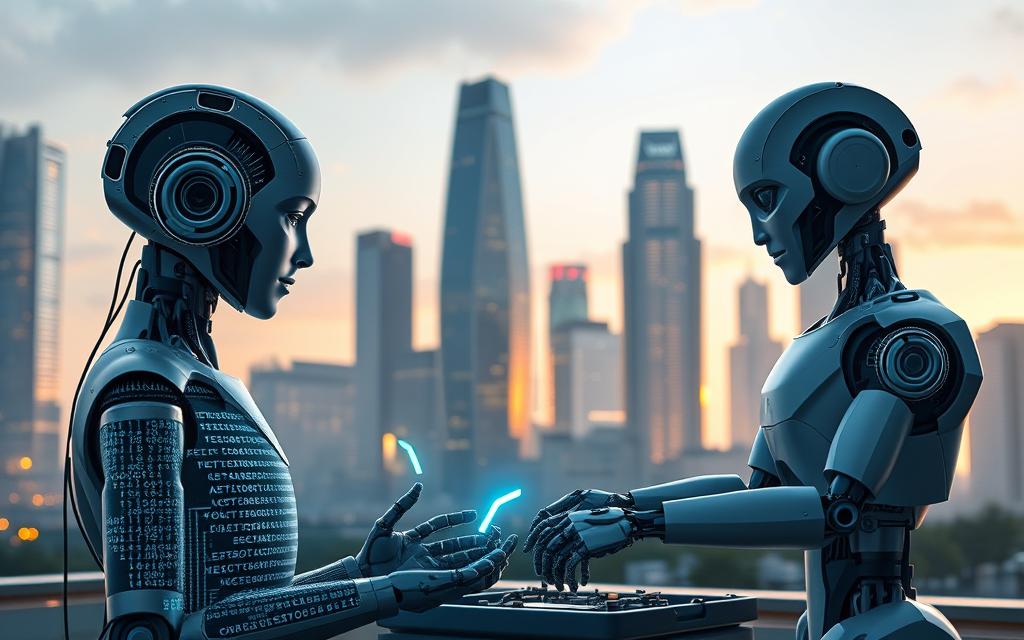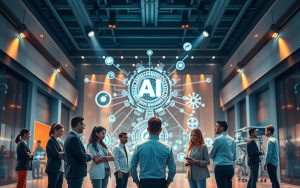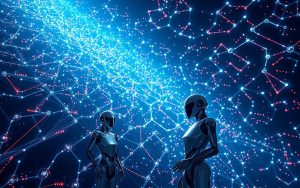Table of Contents
The tech world buzzes with debates about automation’s impact on developers. Some fear software roles might vanish, but history tells a different story. For decades, tools promised to replace programming jobs—yet demand only grew.
Industry veterans with 40+ years of experience confirm: creativity and problem-solving define this work. Machines excel at repetitive tasks, but designing systems requires human intuition. IBM’s data shows AI aids developers, not replaces them.
Global software needs outpace talent supply. This paradox ensures jobs evolve, not disappear. While figures like Zuckerberg speculate on automation, real-world trends highlight collaboration between tech and human ingenuity.
The future belongs to those who adapt. Programming remains rooted in strategic thinking—a skill no algorithm can replicate.
The Enduring Myth of Programmer Obsolescence
History reveals a pattern: every new technology triggers fear, but opportunities multiply. The world of code has faced countless predicted doomsdays—none materialized. Instead, the industry grew richer with each innovation.
Historical Predictions vs. Reality
In the 1990s, CASE tools promised to automate systems design. Yet, engineers adapted, focusing on higher-level architecture. By the 2000s, outsourcing sparked panic—but U.S. tech jobs increased 22%.
Frameworks like Rails and Django simplified workflows. Instead of reducing jobs, they fueled a $1.2 trillion global software market. Today’s AI tools follow the same trend.
Why Past “Threats” Failed
Abstraction layers created niches: DevOps, cloud specialists, and AI trainers. Salesforce’s retail tools show how automation expands roles. Meanwhile, VPN breaches prove machines need human oversight.
| Era | “Threat” | Outcome |
|---|---|---|
| 1990s | CASE Tools | More design-focused jobs |
| 2000s | Outsourcing | Higher domestic demand |
| 2020s | AI Assistants | New specializations |
Complex systems require creativity—a career constant for 50+ years. The cycle repeats: tools augment, but never replace, human ingenuity.
AI’s Current Role in Programming: Assistant, Not Replacement
Modern coding environments now integrate smart assistants that boost efficiency. These tools handle repetitive tasks, letting developers focus on creative problem-solving. IBM’s study shows 81% of tech teams use them daily.

How AI Augments Developer Workflows
Large language models solve specific problems 60 times faster than manual methods. For example, AI coding assistants automate bug detection and documentation, saving hours each week. Microsoft’s Surface team reported a 40% drop in debugging time.
Yet, human oversight remains critical. A recent analysis found AI-generated code often contains security gaps. Meta’s engineers noted these tools struggle with business context.
Tasks AI Can’t Replace
While AI excels at pattern recognition, system design and UX decisions demand human intuition. The table below contrasts capabilities:
| Task | AI Performance | Human Edge |
|---|---|---|
| Code suggestions | High accuracy | Strategic relevance |
| Bug detection | Fast but shallow | Deep root-cause analysis |
| Architecture | Limited | Holistic business alignment |
Retail giants like Salesforce use AI for data processing but rely on engineers for customer-facing design. This balance ensures performance without sacrificing creativity.
Will AI Put Programmers Out of Business? Productivity vs. Demand
Economic trends in tech reveal a surprising twist—automation fuels job creation. This phenomenon, known as Jevons Paradox, shows how efficiency gains expand markets. For every 1% drop in software costs, demand jumps 1.5%.
The Software Shortage Paradox
Enterprise backlogs prove the gap between supply and need. Global companies report 18-month delays for custom software development. AI tools reduce cost, but they also unlock new use cases—creating more work for developers.
“When ERP systems became affordable, customization requests tripled.”
How Lower Costs Drive More Demand for Engineers
IBM predicts 45% of tech roles will require AI collaboration skills by 2026. This shift mirrors past transitions, like cloud adoption. The table below highlights the relationship:
| Cost Reduction | Demand Increase | New Roles Created |
|---|---|---|
| 10% (AI tools) | 15% | AI integration specialists |
| 20% (low-code platforms) | 30% | Citizen developer trainers |
Emerging markets like Africa and Southeast Asia now access software development at scale. This expansion relies on engineers who blend technical experience with AI fluency. The future isn’t replacement—it’s collaboration.
The Human Edge: Why AI Can’t Replace Programmers Entirely
Behind every successful software project lies human ingenuity that machines can’t replicate. While automation handles repetitive tasks, the essence of software development demands creativity and contextual understanding. Fortune 500 companies confirm this—zero use fully AI-designed systems.

Creativity and Problem-Solving in Software Development
Requirements analysis fails 72% of the time without human input. This critical phase involves:
- Interpreting vague business needs
- Balancing stakeholder conflicts
- Predicting edge cases algorithms miss
Tencent’s 2023 case study showed AI-generated prototypes lacked emotional intelligence. Their UX team redesigned 89% of automated outputs to meet human expectations. As one lead engineer noted:
“Machines optimize for metrics—humans design for joy.”
The Irreplaceable Role of System Design and Strategy
Strategic technology decisions require:
- Ethical risk assessment
- Long-term maintainability planning
- Business-architecture alignment
Performance optimization exemplifies this divide. While AI suggests code improvements, humans understand organizational constraints. The contrast is clear:
| Aspect | AI Capability | Human Advantage |
|---|---|---|
| Ethical choices | Rule-based compliance | Moral reasoning |
| System architecture | Pattern replication | Innovative structures |
| Tech investments | Cost analysis | Strategic vision |
This balance defines modern development. Tools evolve, but the human edge in design thinking remains unmatched across industries.
Tech Leaders’ Perspectives on AI and Programming Jobs
Tech giants and startups hold opposing views on automation’s role in software development. While Meta forecasts significant workforce changes, 30-year veterans report a 22% surge in entry-level positions. This divide reflects broader tensions in the industry about the pace of transformation.

Mark Zuckerberg’s Mid-Level Engineer Prediction
Meta’s CEO anticipates AI handling 40% of mid-level programming tasks by 2025. Internal documents reveal:
- 15% reduction in junior engineer hiring since 2022
- New “AI Supervisor” roles paying 28% above standard salaries
- Duet AI adoption cutting code review time by half
Google’s implementation shows similar patterns. Their Duet AI now completes 32% of routine work, according to 2024 metrics. However, 67% of startups maintain traditional engineering structures, suggesting slower adoption.
Industry Veterans Push Back
Seasoned software engineers challenge these predictions with hard data:
“Our firm hired 22% more entry-level developers last year. AI tools create demand for human oversight, not elimination.”
The table below contrasts FAANG companies with SMEs:
| Metric | FAANG Companies | SMEs |
|---|---|---|
| AI adoption rate | 73% | 41% |
| New roles created | AI trainers | Legacy system specialists |
| Salary growth | +18% AI-focused | +12% traditional |
Freelance platforms show parallel shifts. Upwork reports 56% more jobs requiring AI collaboration skills, while traditional coding gigs grew just 9%. This mirrors the world of tech investing—VC funding for AI-first startups jumped 140% last quarter.
Major firms now retrain staff through programs like:
- Microsoft’s AI Pair Developer Certification
- Amazon’s Machine Learning Mentorship
- IBM’s Cognitive Computing Curriculum
The career landscape evolves, but historical patterns suggest adaptation, not replacement. As with past disruptions, the tech workforce demonstrates remarkable resilience through reinvention.
The Future of Programming in an AI-Driven World
Emerging specializations prove that automation expands rather than contracts job markets. IBM reports an 82% surge in AI business planning integration, creating a $1.24B market for augmented tools. This shift mirrors past technology revolutions where productivity gains spawned new career paths.

Evolving Roles for Software Engineers
Stack Overflow’s 2024 survey highlights three growing niches:
- AI optimization engineers who refine machine-generated code
- Cyber security specialists for AI-audited systems
- Quantum computing interface designers
Prompt engineering roles grew 300% since 2022, proving demand for human oversight. NVIDIA’s GPU programming tools now require hybrid experts who understand both technology and creative problem-solving.
New Opportunities Created by AI Tools
Healthcare developers use accessible coding platforms to build diagnostic apps faster. Augmented reality projects benefit from AI-assisted prototyping, though 78% still need human UX refinement.
“Our AI ethics oversight team grew from 2 to 14 members in 18 months.”
No-code platforms create opportunities for business analysts to collaborate with programming teams. This synergy defines the future of software creation in a machine-augmented world.
Conclusion
The future of coding lies in collaboration, not replacement. With 45 million developers projected by 2030, demand outpaces automation’s reach.
History proves software tools amplify human work. Microsoft’s Copilot+ adoption shows 60% faster project delivery—without cutting jobs.
New tech roles emerge, from AI trainers to ethics auditors. The key? Lifelong learning and adaptive skills.
Programming endures as a creative discipline. As one veteran noted, “This is the golden age for builders.” Embrace the tools, but trust human ingenuity.
FAQ
Will AI eliminate programming jobs in the future?
No. AI enhances productivity but cannot replace human creativity, problem-solving, and strategic thinking in software development. Demand for skilled engineers continues to grow.
How does AI currently assist software developers?
AI tools automate repetitive tasks like debugging, code suggestions, and testing. They boost efficiency but still require human oversight for complex logic and system architecture.
Why haven’t past technological advancements replaced programmers?
New tools like compilers and IDEs increased productivity but also expanded software needs. Similarly, AI will create more opportunities rather than reduce jobs.
What skills will remain valuable for developers in an AI-driven industry?
Creativity, system design, and problem-solving remain irreplaceable. Engineers who adapt to AI tools will lead innovation in tech.
Will entry-level programming jobs disappear due to AI?
While AI may handle basic coding tasks, junior developers will shift toward higher-value work like optimization, customization, and AI tool management.
How do tech leaders like Mark Zuckerberg view AI’s impact on engineering roles?
Many predict AI will augment mid-level engineers by handling routine work, allowing humans to focus on complex challenges and innovation.
Does AI reduce the need for software engineers in the long term?
No. The demand for software solutions grows faster than AI can automate development. Engineers will remain essential for designing and maintaining systems.









